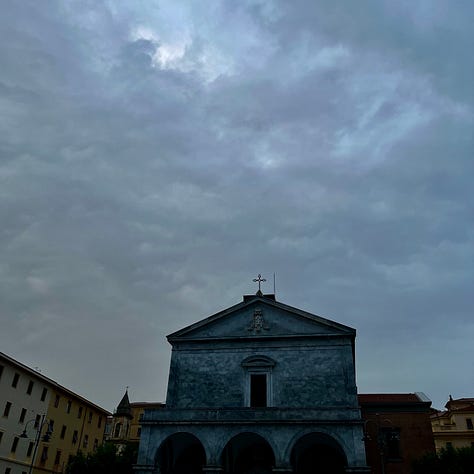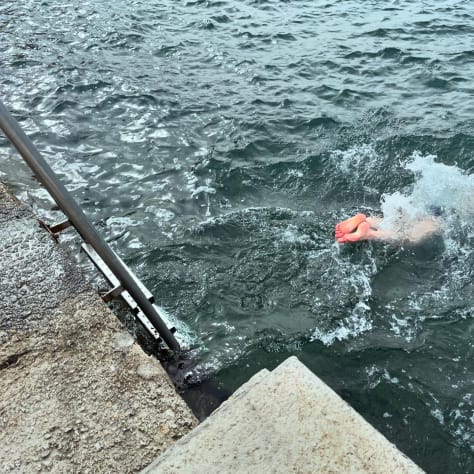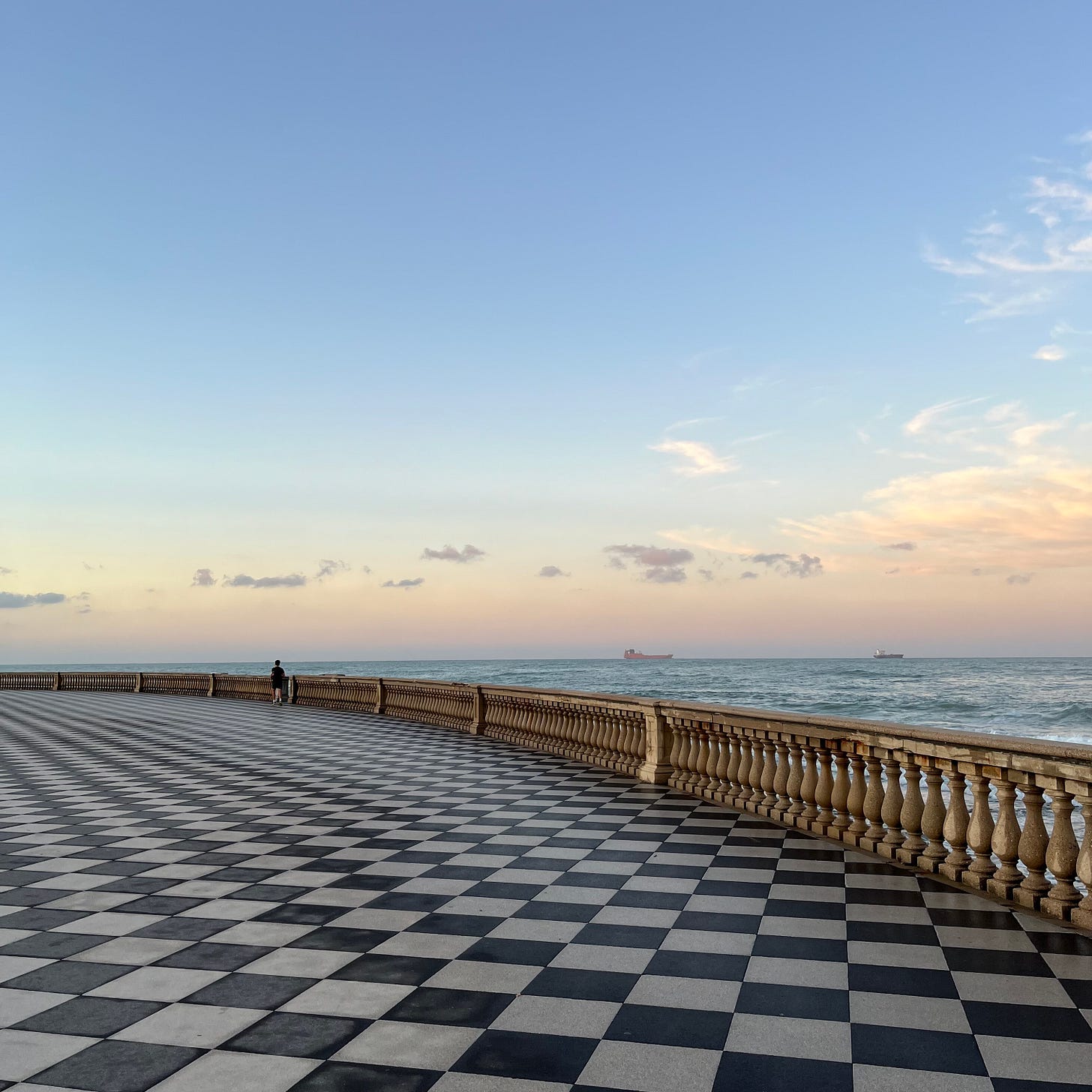Mari e Monti: 72 hours of Thunderstorms in Livorno
Tuscan ratatouille; tuna panino; chanterelles and lupini clams (non chronological)
Sunday —
As you read this sentence, there are about two thousand thunderstorms in progress worldwide.
As I was writing this, heavy and warm raindrops were beating the pavement outside my window in Livorno, evaporating as soon as they touched ground before condensation dollops climbed back towards the sky, and through my nostrils. Summer rain smells promising, like a collection of old stamps in an antique shop, a flood after the drought. If it weren’t for the squalls, the storming trees and the blowing blinds, we’d be breathless; it’s a hot September, Tuscany becomes red again, ‘Severe Weather Alert’ notifications pop, and lightning struck Livorno last Sunday.
The last time I was in Livorno, we still lived there with L. As coincidences happen, we stayed in the same building and floor as where we are this week, but it was located at the other end of the corridor. Only we’ve come for a swift visit this time, and I’m feeling unhinged by the chronology – to be in such a place, which I miss when I’m not physically present, with the anticipation of having to leave again – so I’m unbearable to myself and others. Agitated, at least. I run, panting; I dive into the water by the Chiesa di San Jacopo, swimming; I forget what I went to buy at the market, so I will have to pop out again and again; the grapes are filled with seeds, fleshy and sour, I can’t get enough of them, and the tall and chatty fruit merchant knows as much. Then the rain poured and poured and poured, and there I sat. There I stood at the kitchen counter too, grilling courgette flowers, sweating white onions and slow cooking purple aubergines and yellow peppers, and I thought that if we have come back, and if we will leave again, then we’ll be able to return, time and again. We ate my famous Tuscan ratatouille for dinner on that Sunday.
Ingredients: white onion, finely sliced; yellow peppers, cut lengthwise; aubergine, cubed; courgettes, cubed, and their flowers, preserved; passata, one vegetable stock cube; oregano, salt and pepper.
Method: in a large pan, sweat the white onion in olive oil, with a pinch of salt and plenty of oregano. Once the onions look glassy, add the peppers, stir and throw a (small) gulp of water. As soon as the water has evaporated, add the aubergines. Cook for 10 minutes, stirring occasionally. In the meantime, grill the courgettes and their flowers, either in a pan or in the oven, with some olive oil. Return to the aubergines and add the passata, throw another gulp of water (passing it through the passata recipient so you can clean it at the same time) and the veggie stock. Sprinkle pepper and more oregano. Lower the heat and simmer for a good 20 minutes. Stir if needed, though gently not to mash the vegetables; it should be solidifying, drying and coming together. Serve the tomatoey mixture, topping it with the grilled and crunchy courgettes.



I still remember my first thunderstorm Livornese. I was home alone and scared; it happened in November, during the deep hour of the night. A thunderstorm occurs in a circuit, when warm and moist air rises into cold air, cooling down through a condensation process, then the chilled air drops lower in the atmosphere, before warming up and rising again. Air rises and falls, the same rotation as a levain or a sourdough starter so one can break bread, like great expectations before the challenges of trading with the business of being alive and, eventually, a cloud will develop from such an energy – called a convection cell – until it will be strong enough to burst into a thunderstorm. Thunder comes from lightning, so all thunderstorms have lightning; a thunderstorm is a predictable meteorological event, or a threat.
The last time we were in Livorno with L., it was winter. The sky had the same misty blue as it did on Sunday morning, before the storm, though the shade was sharper, scored by cold rain. This week, at the end of one of the hottest summers ever recorded, the clouds are brewing a new side of blue. It’s thick and harsh – the coastline at that corner of the Tyrrhenian Sea is flat, and the waves often roll over the pedestrians’ barriers by the seafront, spraying onto the road. The lungomare in Livorno is my favourite running route – the saltiest of sweats, a cold shower at summertime and a rush of adrenaline during the winter months – ambivalent and demanding.
Italy is a land where I cheat. Home away, my French accent is softer in Italian than in English yet my tongue is more slippery, feeling warm and close to her mother. Be careful though, the French and the Italian languages are false cousins – or, as my grandmother, who has equally strong opinions about the above ratatouille recipe, used to tell me: ‘Italian is a French sentence spoken with a smile.’
At the bar, back from my run, a panino with tuna, tomatoes and lettuce. Italy is the land of savoury breakfasts too.
Saturday —
On Saturday night, a thunderstorm broke the heavens a few minutes after we had sat at a terrace for dinner. The power of the rain was sudden, but the loud drums of thunder had served as a prequel, and, as water did come for us, everyone stood, grabbed an end of their table and walked inside the restaurant with it. A thunderstorm, which can be summarised as a rain shower during which you hear thunder, is a common weather event.
Livorno is a port city. As I was writing this email to you, thirty-one vessels had arrived within the last twenty-four hours and twenty ships were expected to arrive in the next thirty days. You can’t be looking at the sea and not be sighting a cargo ship, which is how I fell in love with Livorno when we first came here. I’m never able to feel lonely in port cities: they have an edge attached to them, a certain pragmatic mess, the movements of people coming and going, returning or not. Workers at the port unload ferries late into the night, the lamps bright in lieu of star gazing, and fishermen untangle nests at dawn, always going and coming, merging sea and land; it’s easy to be alone with yourself too, flowing.
Menus on display outside of restaurants are abundant with seafood, but Livorno is Tuscan and Tuscany is proud of its hills. Seafood is never cooked far from the land.
(More recipes and stories from Livorno can be found in an earlier newsletter)
Monday —
On Monday morning, I was running the lungomare again. The sky had cleared but the sea was resentful. Foamy and pungent, imposing and mercurial; irresistible, if you asked me, so I swam at the end of the footpath. The geography of Livorno means that winters are stinging cold and summers are hot and humid, therefore thunderstorms are at home here.
If the sea was buoyant on Monday morning, the market was quiet. Only two stalls were opened in the fish aisle of the Mercato delle vettovaglie, when there are usually over twenty merchants selling to both locals and restaurants, haggling and sharing cooking tips in passing. Fishermen couldn’t take the boats out of the port.
We bought half a kilo of lupini clams, which was half of the last bag of shellfish available, chanterelles and courgette flowers. On Monday night, we cooked something ‘mari e monti’, which is one of our favourite feasts in the kitchen with L., a dish between seas and mountains, or an ode to the negotiation of where home lands – recipe for chanterelles and lupini clams, served with a side of grilled courgette flowers:
500g lupini clams (or clams, depending on the tides where you shop), rinsed in cold water
1 bunch of parsley, finely chopped
1 white onion, finely chopped
2 handfuls of chanterelles, roughly chopped
Courgettes and courgette flowers, halved lengthwise
Ground cumin, black pepper and garlic
In a pan, gently fry the parsley and the white onion with a generous amount of olive oil.
In the meantime, preheat the oven to 180C fan. In a bowl, mix the courgettes with olive oil and salt. Lay on a baking tray and bake.
Return to the frying pan, add the chanterelles and cook for 10 minutes. With the help of a fork or a wooden spoon, reduce the mixture into a rough paste. Lower the heat to a minimum.
In a large pan, cook the lupini clams over a medium heat. Wait until they open fully. This will both cook and clean them. Drain the lupini clams over a bowl, preserving the salty water they’ll have released in the cooking process. The next step will place you at risk of burning yourself, but it’ll be rewarding in taste. Return the clams to the pan, add the mushroom preparation and mix well over a low heat. Being mindful of the heat, pass the cooking water through a kitchen towel so it’ll be purged from the sand. Mix and leave to simmer for another two minutes.
Lay the grilled courgettes on a plate, spooning the mari e monti mixture on top.
Afterwards —
I exited the flat, locked the door and texted T. to say that we’re gone. I looked to the right, where the other flat stood, its entrance door firmly closed, and I walked down the three flights of stairs. I had started writing this dispatch because I wanted to understand the mechanics behind the storms that scare me, but there are no storms like going home.
Margaux
PS. If you enjoy this newsletter, feel free to forward it to a friend, or two:
And, if you’ve been forwarded this email and enjoyed it, you can:
On Livorno
It’s intoxicating to fall in love with a new place. The experience suits selfish needs, its attractions are rampant with weather and season changes, the untrained eyes of a newcomer and the potential barrier of language. Or the naïve enthusiasm of someone who is learning a new lexicon, no strings attached but new plays on words. It’s the beginning of a …










This was a breathtaking read, I was completely entranced from start to finish. So brilliant!